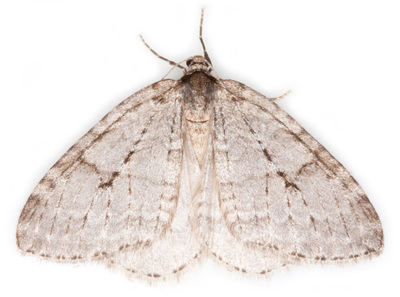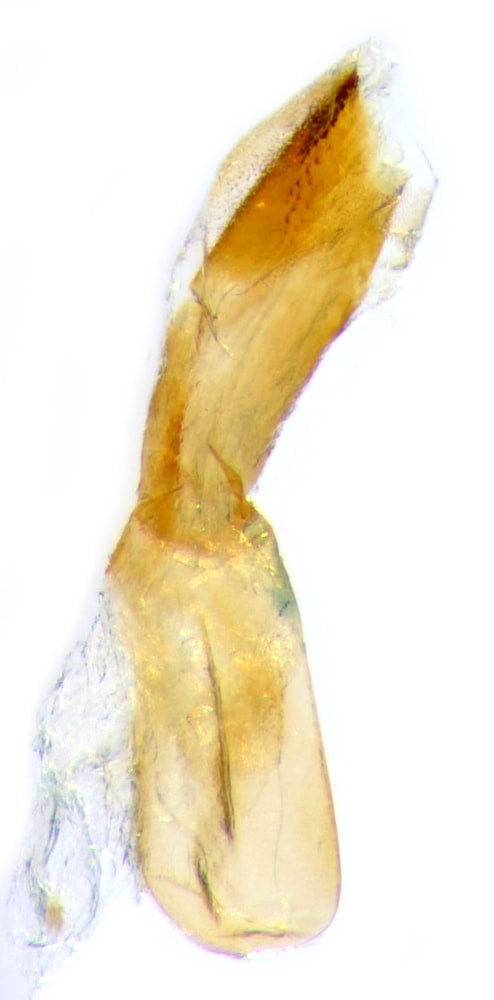73.109 Epirrita autumnata (Autumnal Moth)
fw 16-20mm; Oct-Nov; birch (Betula spp), alder (Alnus glutinosa); common throughout GB
ID: Epirrita species show a more pointed forewing apex than Operophtera species and average larger. Epirrita species cannot be distinguished reliably on external features but well-marked specimens of E.autumnata tend to show an angulation of the forewing postmedian line around the discal spot. In well-marked E.christyi the postmedian line curves around the discal dot and in E.dilutata the postmedian line runs through or very close to the discal dot. However, many specimens are poorly/obscurely marked. E.filigrammaria averages smaller (fw 14-18mm) and can usually be distinguished on biological features - it flies August to September and is more or less confined to to northern moorland.
Male genitalia: Octavals short, widely spaced and inclined medially. Valvae with an angular prominence on the ventral border but without a distinct dentate projection (which is present in E.dilutata and E.christyi). Dissection group suggests that E.autumnata and E.filigrammaria cannot be separated on male genital features. Pierce states that the octavals are smaller with a shallower excavation between them in E.autumnata and that the number of hairs on the christae, ~19 in E.autumnata, ~7 in E.filigrammaria, provides a clear distinction.
Female genitalia: There is probably no reliable means of separating female Epirrita species. Pierce suggests that the signa of E.autumnata are distinctly smaller than those of the other 3 species, however I have found specimens showing forewing features suggestive E.autumnata with quite variably sized signa (this does not rule out the possibility that all specimens with very small signa are E.autumnata but not all E.autumnata have very small signa).
Male genitalia: Octavals short, widely spaced and inclined medially. Valvae with an angular prominence on the ventral border but without a distinct dentate projection (which is present in E.dilutata and E.christyi). Dissection group suggests that E.autumnata and E.filigrammaria cannot be separated on male genital features. Pierce states that the octavals are smaller with a shallower excavation between them in E.autumnata and that the number of hairs on the christae, ~19 in E.autumnata, ~7 in E.filigrammaria, provides a clear distinction.
Female genitalia: There is probably no reliable means of separating female Epirrita species. Pierce suggests that the signa of E.autumnata are distinctly smaller than those of the other 3 species, however I have found specimens showing forewing features suggestive E.autumnata with quite variably sized signa (this does not rule out the possibility that all specimens with very small signa are E.autumnata but not all E.autumnata have very small signa).
§1 Dodd Wood, Cumbria; 10/11/2014; male; fw 18.4mm
§2 Dodd Wood, Cumbria; 10/11/2014; male; fw 18.0mm
§3 Dodd Wood, Cumbria; 10/11/2014; female; fw 17.8mm
§4 Dodd Wood, Cumbria; 10/11/2014; female; fw 17.2mm
§5 Pound Wood, Essex; 01/11/2015; male; fw 19.2mm
§6 Pound Wood, Essex; 01/11/2015; male; fw 18.3mm
§7 Lochcarron, Wester Ross; 21/09/2019; male; fw 18.2mm
All images © Chris Lewis
§2 Dodd Wood, Cumbria; 10/11/2014; male; fw 18.0mm
§3 Dodd Wood, Cumbria; 10/11/2014; female; fw 17.8mm
§4 Dodd Wood, Cumbria; 10/11/2014; female; fw 17.2mm
§5 Pound Wood, Essex; 01/11/2015; male; fw 19.2mm
§6 Pound Wood, Essex; 01/11/2015; male; fw 18.3mm
§7 Lochcarron, Wester Ross; 21/09/2019; male; fw 18.2mm
All images © Chris Lewis
Page published 09/12/2014 (§1-4) | §5&6 added 24/11/2015 | §7 added 18/12/2019



































